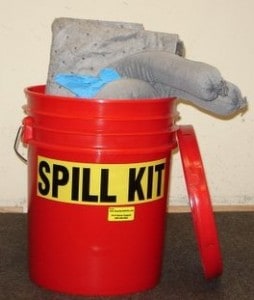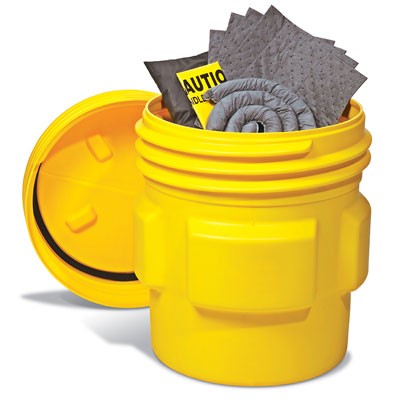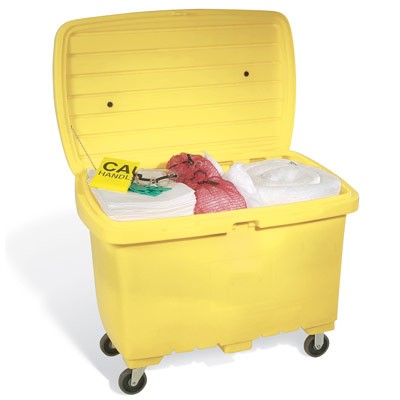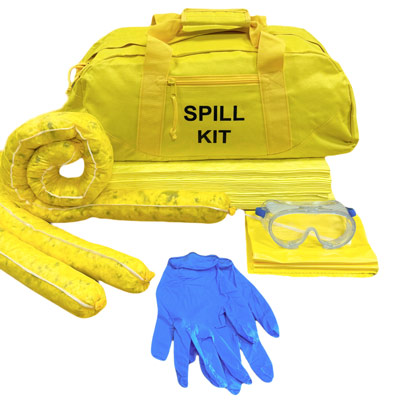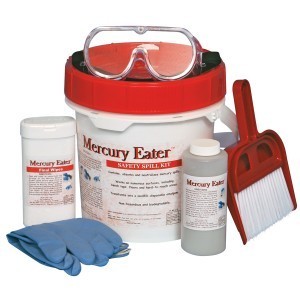One Size Spill Kit Doesn’t Fit All
Being prepared with a well-equipped spill kit is just as important as having a fully stocked first aid kit: No matter where you are, no matter what you do … spills happen. It’s a natural fact of life! But in your place of business, it’s especially important to have the correct tools on hand to clean up spills before they cause damage or injuries to personnel or plant.
It’s a no-brainer that quick response is key to addressing any spill scenario. But what are “the correct tools” for an emergency response to surprise spills? And, what’s the best approach for spill control and remediation?
Spill response kits (not to mention the spills themselves) are not one size fits all. You need to ensure that you are prepared for exactly the type of spill that you will be facing. Only when you have the appropriate spill kits for your facility, and the materials you use there, will you be able to face any potential disaster with confidence.
What spill risks exist at your job site?
Your facility is unique — and along with that unique identity come unique potential issues. There are many different risk factors for you to look at and think about. Which equipment, machinery, or areas are particularly prone to spills? What kinds of liquids do you have on-site? How many volumes of materials are you storing? Where and how do you house or transport those fluids? Forklifts moving pallets, IBC totes, and other large storage containers around can present a prime hazard for punctures!
Other things to consider are the location and potential size of your spills — will you need to clean up small leaks, or massive spills? Keep in mind the requirements for your industry and the type of spill kit container you will need. Does your spill response kit need to be used outdoors, or inside? Different types of containers will be best suited for different spill volumes (for instance, bagged or bucket spill kits will do fine for small spills, but large-volume spills might require a drum or a mobile spill kit in a wheeled cart).
You’ll want to review all of these things—and more—before you go looking for the right spill kit. Make sure to consider the worst-case quantities that could be spilled in various different locations.
What items are necessary in a spill response kit?
Once you know what your facility’s risks are, you can find the spill kit that matches them. What materials will you need in your kit? Perhaps pads and rolls, absorbent pillows, or absorbent socks. Each material has its own strengths, so you should read up on the particular uses for each type to determine which is best for you.
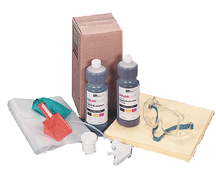
Safety gloves, goggles, sorbent pads, disposal bags and more come in battery acid spill response kits
Besides absorbents, other spill kit contents usually include things like disposal bags for soiled clean-up materials, nitrile gloves for safe material handling, and goggles for eye protection.
Spill kit refill materials are often available to purchase separately, so you can re-stock or augment your kit as necessary.
Select the right spill kit for the job
Just like your facility is unique, so is each spill kit. There are different kit types designed to most efficiently handle small to large spills of different liquid categories.
The three main types of spill cleanup kits tend to be color coded, to help easily identify and use the right kit for the right spill cleanup. The kit types include:
-
Universal or General Purpose Kits
These cleanup kits can handle both water-based fluids and hydrocarbons. The universal absorbents and cleaning materials in these kits are usually gray.
Universal spill kits are a good option for locations storing or using coolants, paints, solvents, and other non-hazardous materials and chemicals.
-
Oil Only Spill Kits
Dealing with hydrocarbons? The absorbent pads and contents in Oil only kits are generally white in color. The materials repel water and can be used to clean up motor oil, jet fuel, diesel, gasoline, lubricants, and hydraulic oil spills, among others.
An oil-only kit is an obvious choice for automotive/mechanical equipment shops as well as marine locations.
-
Hazmat/Chemical Spill Kits
Hazmat kits will allow you to clean aggressive fluids such as acids and solvents. Absorbents in these kits are typically yellow in color and are for both hydrocarbons and water-based fluids.
This type of kit is great for labs and other sites handling or storing hazardous materials and chemicals to meet OSHA requirements.
Spill kit container and size options
Various size drum spill kit options exist to cater to large spills, including a 95-gallon spill kit with contents in a poly drum, ready to handle volumes up to 84 gallons. And don’t forget about mobile spill kits: overpack drums or large carts that feature caster wheels on the base for fast and easy transport to spill sites.
A duffel bag or fleet spill kit might be best for smaller spills, or, stashing inside emergency response vehicles. Bucket-style spill kits also make a convenient, grab-and-go option that is highly portable for attending to mid-size spill cleanups.
What other spill response kit options are there?
In addition to the three main kit types above, there are also various specialty kits available for fast spill containment and response. These options include kits for hazardous waste (such as body fluid kits for biohazard materials), mercury spill kits, as well as spill kits for battery acid.
Remember: workplaces will often need one or more types of spill kits on hand. It’s important to regularly inspect spill kits for missing or damaged items and then order refill kit items, as necessary.
If none of these kits seem like the right match for you, don’t worry! Talk to AbsorbentsOnline and we can build a custom kit that meets all your needs and leaves you confident in your ability to handle any spill.
We also have a wide range of other spill response products for convenient and quick order, to store in your safety cabinet or janitorial closet. Just a few suggestions to consider are wipers, drain plugs, drip pans, and containment berms.
 Have questions about which absorbents or spill response kits are right for your needs? Contact Travis Zdrazil at travis@absorbentsonline.com or (800) 869-9633.
Have questions about which absorbents or spill response kits are right for your needs? Contact Travis Zdrazil at travis@absorbentsonline.com or (800) 869-9633.
This is a revision to a post with an original publication date of July 10, 2015.
